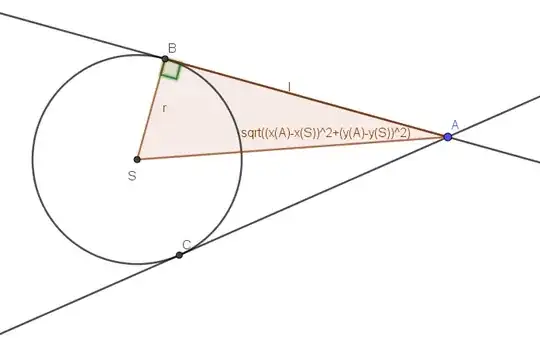Given the conic equation $a_{11} x^2 + a_{22} y^2 + 2a_{12}xy + 2a_{13} x + 2a_{23} y + a_{33} = 0 $
The conic is non-degenerate if the determinant of the symmetric matrix $a_{ij}=a_{ji}$ is not zero
$$A=\left|
\begin{array}{ccc}
a_{11} & a_{12} & a_{13} \\
a_{21} & a_{22} & a_{23} \\
a_{31} & a_{32} & a_{33} \\
\end{array}
\right|\ne 0$$
you can write the equation of the polar line from an external point $P(x_0,y_0)$
$$(a_{11} x_0 + a_{12} y_0 + a_{13} )\,x + (a_{21} x_0 + a_{22} y_0 + a_{23} )\,y + a_{31} x_0 + a_{32} y_0 + a_{33} = 0$$
This line intersects the conic in the points where the tangents do, so you can solve the system between the conic and the polar and find the distances from the intersection points to the point $P$
In the example of Jan Magnus we had
$x^2-xy+y^2-1=0$ so that $a_{11}=1;\;a_{12}=a_{21}=-\frac12;\;a_{22}=1;\;a_{33}=-1$
and the point is $P(-2,0)$
Thus the polar line has equation
$-2x + \left(-\frac12 (-2) \right)\,y -1= 0 $ that is $y=2x+1$
plug this equation in the equation of the conic, to solve the system
$x^2-x(2x+1)+(2x+1)^2-1=0$ that is $3 x^2+3 x=0$ which gives $x_1=0;\;y_1=1$ and $x_2=-1;\;y_2=1$ Intersection points are $A(0,1)$ and $B(-1,1)$
We find $PA=\sqrt 5$ and $PB=\sqrt 2$
Hope this helps
